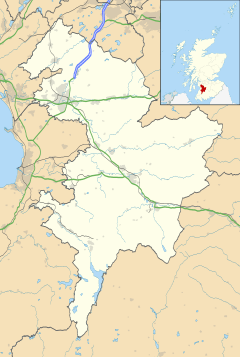Dalrymple, East Ayrshire facts for kids
Quick facts for kids Dalrymple
|
|
|---|---|
 Dalrymple Railway Viaduct to the north of the village |
|
| Population | 1,660 (2020) |
| OS grid reference | NS361146 |
| Council area | |
| Lieutenancy area |
|
| Country | Scotland |
| Sovereign state | United Kingdom |
| Post town | AYR |
| Postcode district | KA6 |
| Police | Strathclyde |
| Fire | Strathclyde |
| Ambulance | Scottish |
| EU Parliament | Scotland |
| UK Parliament |
|
| Scottish Parliament |
|
Dalrymple (also known as Scots: Drumple in Scots) is a village in East Ayrshire, Scotland. It is located in the Doon Valley, right on the north side of the River Doon. Around 1,347 people live in Dalrymple.
The name Dalrymple comes from an old Gaelic phrase. It means "flat field of the crooked pool or river." While the parish and church of Dalrymple are quite old, the village itself is more modern. It was first set up around the year 1800. Back then, it only had two main streets: Main Street and Garden Street.
How Dalrymple Grew
The village grew slowly for many years. In the late 1900s, more homes were built. These were council housings. They helped house families from nearby coal-mining villages. These villages were facing tough economic times.
Village Life Today
Today, Dalrymple has about 1,000 houses. You can find two pubs there, including The Kirkton Inn. There is also a hotel with self-catering studios and a restaurant. The village has a hairdresser, several shops, a chemist, and a post office.
Dalrymple also has its own primary school. For high school, students usually go to schools in Ayr, Maybole, or Dalmellington. Ayr is about 6 miles (10 kilometers) north of Dalrymple by road.
Village Boundaries
The River Doon forms the southern edge of the village. To the west and north, the Purclewan Burn acts as another natural boundary.
Newer homes in Dalrymple have mostly been built on the eastern side of the village.
Housing Changes
By the middle of the 20th century, most of the houses in Dalrymple were built by the local Council. However, things started to change in the 1980s. Many people bought their Council homes. More recently, all new housing developments have been built by private companies.
The older parts of the village, like Garden Street and Main Street, are often called the 'bottom end' by local people. The newer areas are known as the 'top end'.
See also
 In Spanish: Dalrymple para niños
In Spanish: Dalrymple para niños


